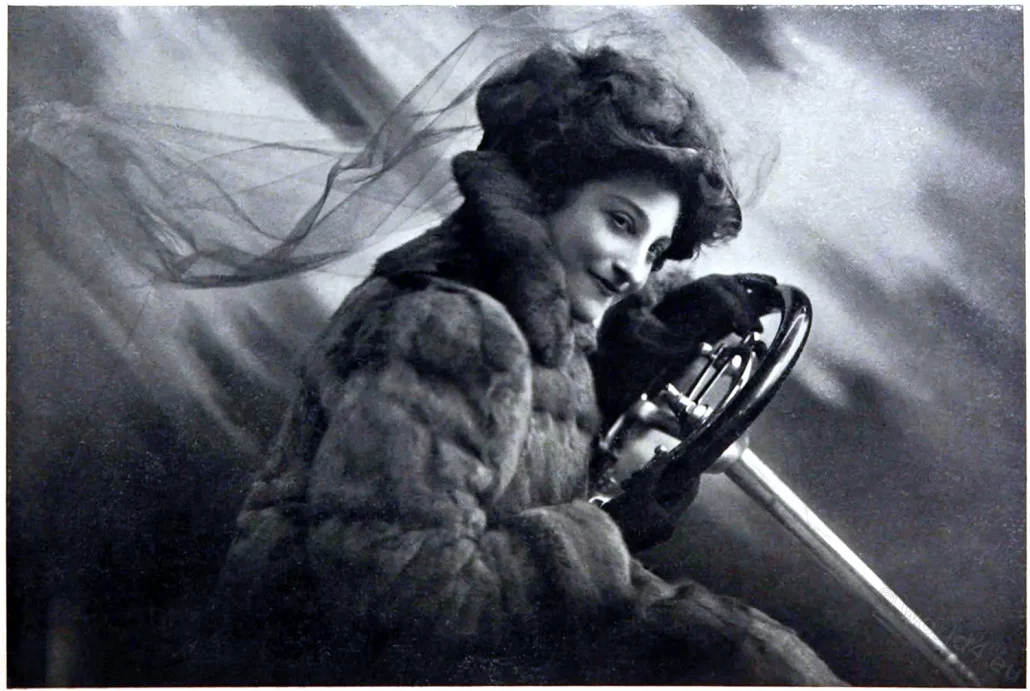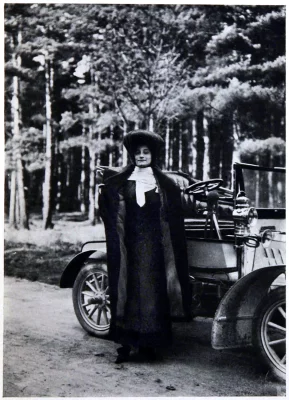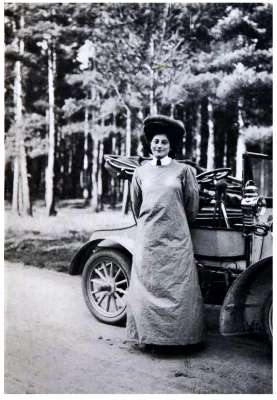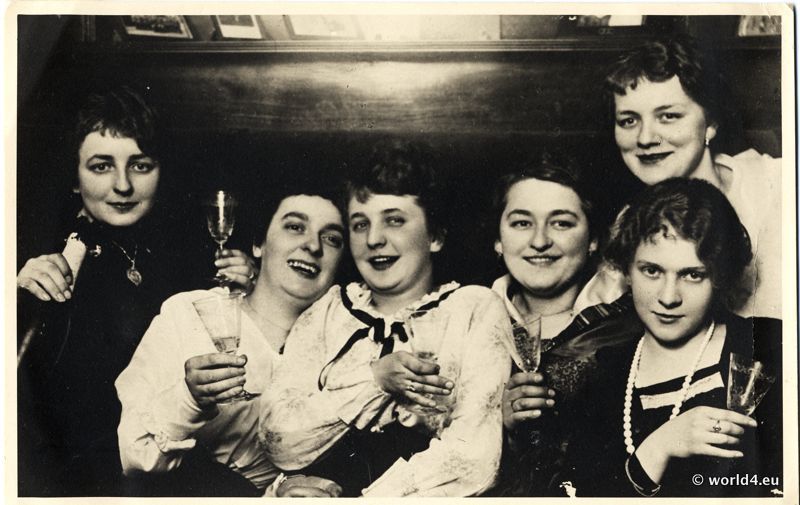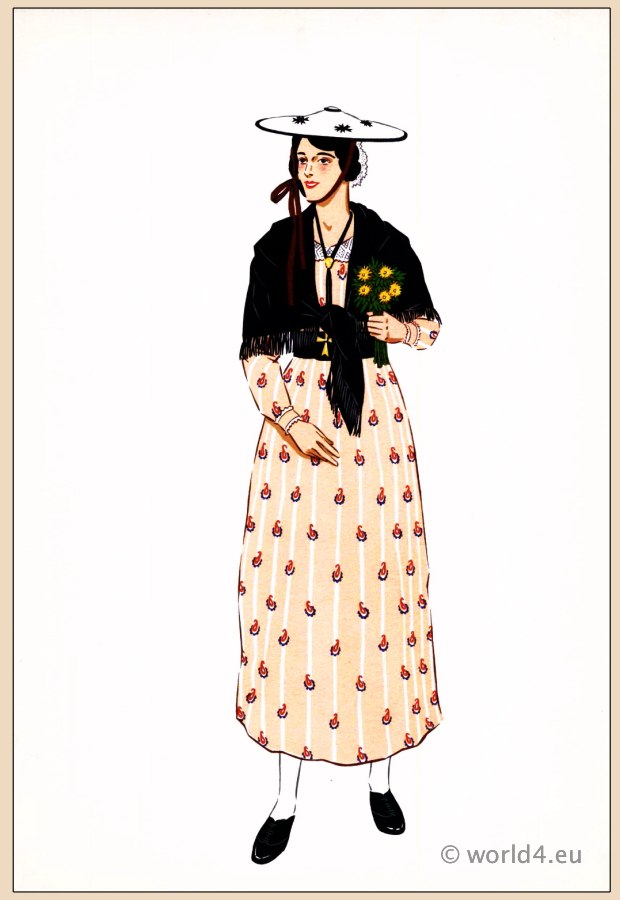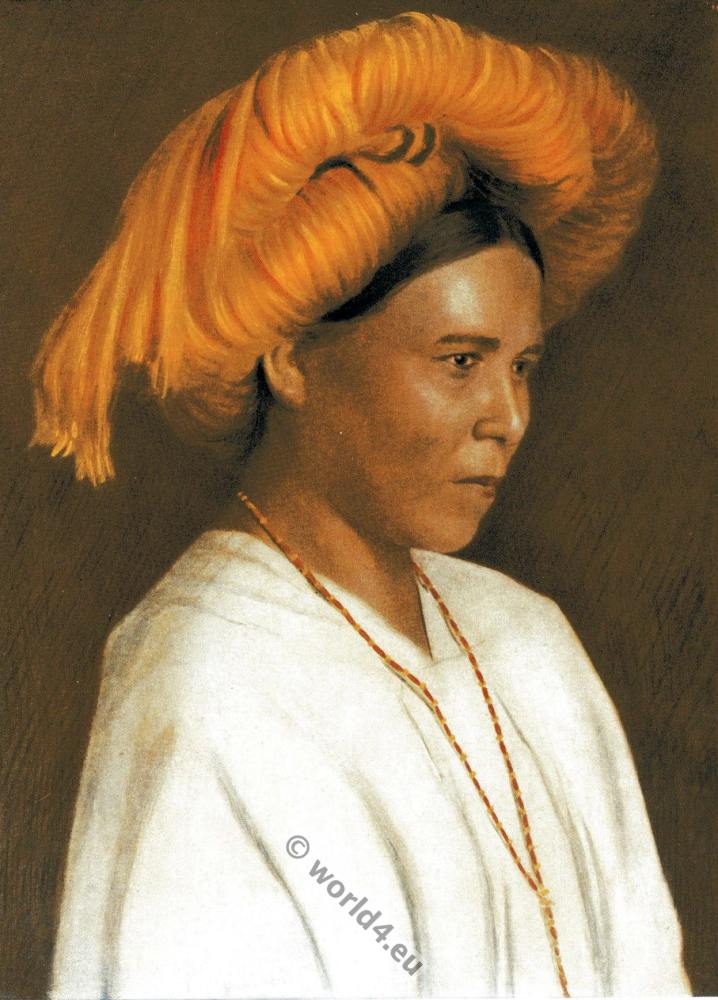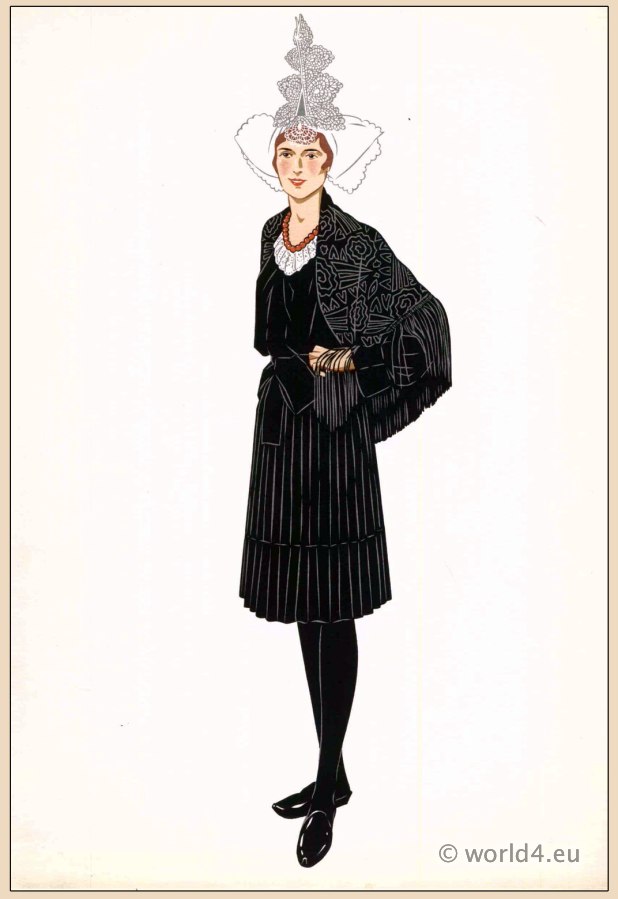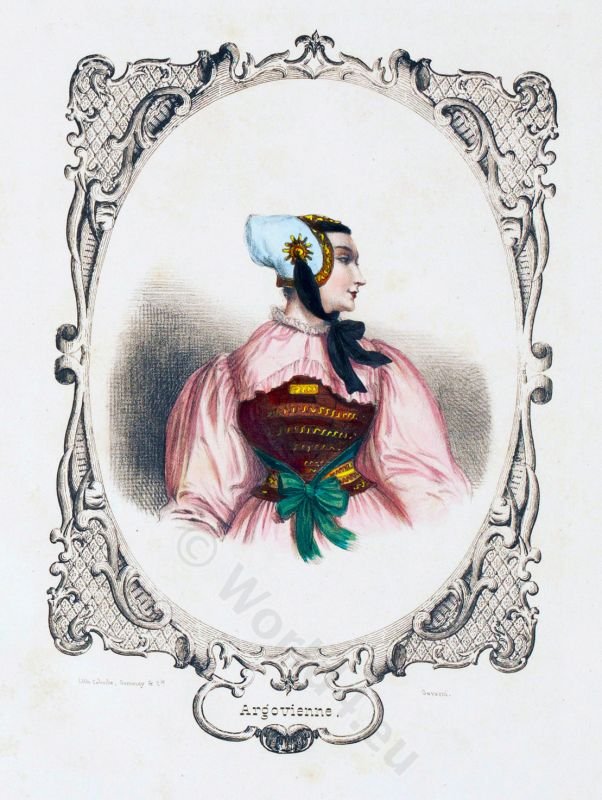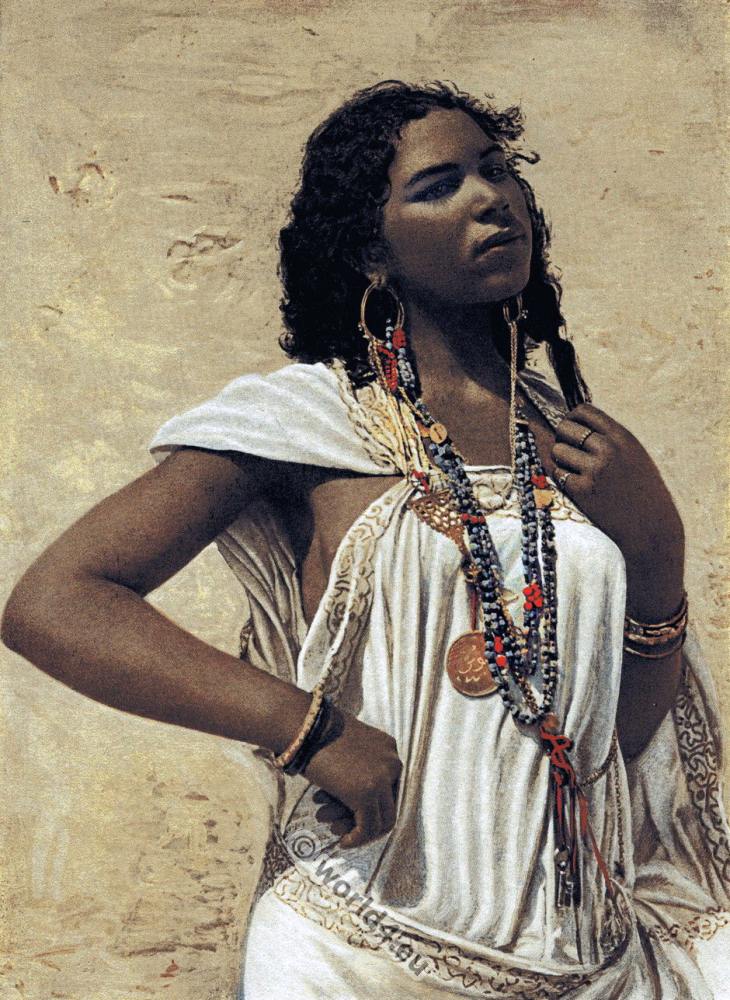The Woman and the Car. The all-important question of dress.
Levitt, Dorothy (1882-1922), The Woman and the Car – A chatty little handbook for all women who motor or who want to motor.
CHAPTER II
THE ALL-IMPORTANT QUESTION OF DRESS
Content: The All-important Question of Dress—Masks and Goggles are usually unnecessary— “Nothing like Leather” is a False Cry—The best Head-gear—A Neck-muffler is of the greatest Importance—Beware of Rings and “fluffy” Things—The Question of the Overall—What the Secret Drawer should contain—Hints about all Garments—Suggestion anent carrying a Revolver.
AN all-important question is dress. Automobilists are nowadays more careful in the choice of their attire, but there are still a goodly number who seem to imagine it is impossible to look anything but hideous when in an automobile. On a closed-in car, Limousine or Landaulette *), any kind of attire is permissible as the conditions are precisely the, same as being driven in a carriage, but with an open car neatness and comfort are essential. When racing, or when in countries where speed is not looked upon with such horror as in England.
*) Landaulet (also Landaulett or Landaulette) refers to a class of vehicle with a partially closed body whose rear roof section can be opened completely like a convertible. Because the term refers to the roof as a single feature of the vehicle, it is often used in conjunction with the actual body style, such as “Sedan-Landaulet” or “Pullman-Landaulet”. The size of the roof section that can be opened can vary. Window frames are removed or not provided at all —on the long, straight seemingly never-ending, military roads of France, one can travel at a speed that makes goggles or masks a necessity, but for motoring under ordinary conditions there is no reason why one should wear them.
It might be borne in mind that I am writing this book for the woman who is desirous of being her own driver and owning her own car ; yet perhaps my advice will be applicable to the whole sex. I average about 400 miles per week—in all conditions of weather—all sorts of cars and all sorts of places, and therefore speak from experience—in many instances dearly bought.
Now, as to ordinary garments, dress for the season of the year exactly as you would if you were not going motoring. I would advise shoes rather than boots as they give greater freedom to the ankles and do not tend to impede the circulation, as a fairly tightly laced or buttoned boot would do, but this is a matter of individual taste. In winter time it is advisable to wear high gaiters, have them specially made, almost up to the knee.
ONE OF THE MOST IMPORTANT ARTICLES OF WEAR IS A SCARF OR MUFFLER FOR THE NECK. Photo. H. W. Nicholls.
As regards a frock—the plain “tailor-made” with a shirt blouse of linen, silk or “Viyella” is without doubt the most comfortable—and the wearer has the advantage, at the end of a days’ run, of appearing trim and neat. Under no circumstances wear lace or “fluffy” adjuncts to your toilette—if you do, you will regret them before you have driven half a dozen miles.
Regarding coats—there is nothing like a thick frieze, homespun, or tweed, lined with ” Jaeger ” or fur. The former has the advantage of being lighter in weight than the latter and is just as warm and much less expensive. In England in winter one can wear a coat of this description right up to the beginning of summer. For summer itself, the ideal coat is of thin cream serge. It retains its freshness and does not crease like alpaca, linen or silk. The serge looks, and feels, smart all the summer —the silk or alpaca, after its first hard day, begins to look creased and shabby.
Do not heed the cry “nothing like leather.” Leather coats do not wear out gracefully. At first they may be delightful, but when they have been caught in two or three showers they begin to have a hard, stiff feeling which is far from comfortable. I have, however, seen very pretty costumes, coats and skirts, made of thin glove kid, or suède, but these are luxuries, as they cost from twenty-five to thirty guineas each.
As to head-gear, there is no question: the round cap or close-fitting turban of fur are the most comfortable and suitable, though with the glass screen up it is possible to wear an ordinary hat, with a veil round it. However, if you go in for caps, see that they fit well— there is nothing more uncomfortable than the cap that does not fit. It is a good plan to have caps made to match your costumes. When fixing the cap, pin it securely, and over it put a crêpe-de-chine veil, of length a-plenty.
These can be obtained from most of the leading drapers, and it is quite a simple matter to make them yourself with a length of crêpe or washing silk. Before tying the veil, twist the ends. This prevents the knot working loose and is very necessary, as the veil, in addition to protecting the hair, helps to keep the hat securely in place
REMEMBER TO TWIST THE VEIL BEFORE TYING—THIS PREVENTS THE KNOT WORKING LOOSE. Photo. H. W. Nicholls.
One of the most important articles of wear is a scarf, or muffler, for the neck—and the manner of wearing it is also important. Fold it, then wind round the throat, beginning at the front, bringing the ends round from the back, and fold over in front. See that the throat is covered closely, and not too loosely. Wearing this properly will save you all manner of colds, sore throats and kindred sufferings.
Regarding gloves—never wear woollen gloves, as wool slips on the smooth surface of the steering-wheel and prevents one getting a firm grip. Gloves made of good, soft kid, furlined, without a fastening, and made with just a thumb, are the ideal gloves for winter driving.
It is not advisable to wear rings. If you do not want to leave them at home, or in a hotel, but want to wear them when you are indoors, during your ride or tour take them off while on the car and stow them away. Rings, when you are driving yourself, hurt terribly, and also the stones are loosened. Bracelets and bangles are irritating unless secured by a sleeve or glove from working up and down.
Indispensable to the motorist who is going to drive her own car is the overall. This should be made of butcher-blue or brown linen, to fasten at the back—the same shape as an artist’s overall. It should have long sleeves. You can always slip off your coat and put on the overall in a moment—and it is necessary if you have anything to do in the car. Remember it is better to get greasespots on your washable overall than on your coat or other clothes.
While there are several little repairs that it would be impossible to remedy if wearing gloves, the majority of work on a car (filling tanks, &c. &c.) can be done just as well if one’s hands are protected by a pair of washleather gloves. You will find room for these gloves in the little drawer under the seat of the car.
This little drawer is the secret of the dainty motorist. What you put in it depends upon your tastes, but the following articles are what I advise you to have in its recesses. A pair of clean gloves, an extra handkerchief, clean veil, powder-puff (unless you despise them), hair-pins and ordinary pins, a hand mirror— and some chocolates are very soothing, sometimes!
THE USEFUL OVERALL. Photo. H. W. Nicholls.
It is also advisable to carry a tablet of “Antioyl” soap. If it has been necessary to use bare hands for a repair you will nearly always find some grease on your hands, and this it is impossible to remove with ordinary soap. Of course it is possible to remove it with a little petrol, but I have found that petrol roughens the skin and that the “Antioyl” soap is much better.
The mirror should be fairly large to be really useful, and it is better to have one with a handle to it. Just before starting take the glass out of the little drawer and put it into the little flap pocket of the car. You will find it useful to have it handy—not for strictly personal use, but to occasionally hold up to see what is behind you. Sometimes you will wonder if you heard a car behind you—and while the necessity or inclination to look round is rare, you can, with the mirror, see in a flash what is in the rear without losing your forward way, and without releasing your right-hand grip of the steering-wheel.
THIS LITTLE DRAWER IS THE GREAT SECRET. Photo. H. W. Nicholls.
If you are going to drive alone in the highways and byways it might be advisable to carry a small revolver. I have an automatic ” Colt,” and find it very easy to handle as there is practically no recoil—a great consideration to a woman. While I have never had occasion to use it on the road (though, I may add, I practise continually at a range to keep my eye and hand “in”) it is nevertheless a comfort to know that should the occasion arise I have the means of defending myself.
If you are driving alone a dog is great company. The majority of dogs like motors and soon get into the habit of curling up on the seat by your side, under your coat.
Source: The woman and the car; a chatty little handbook for all women who motor or who want to motor by Levitt, Dorothy; Byng-Hall, C., ed. London, John Lane; New York, John Lane Company, 1909.
Discover more from World4 Costume Culture History
Subscribe to get the latest posts sent to your email.

